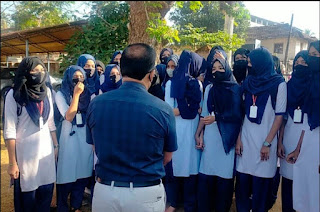NEW DELHI — When the students were barred last month from entering their classrooms and told not to wear hijab, a headscarf used by Muslim women, they began camping outside the all-girls high school.
The story cascaded across the internet, drawing news crews to the front of the government-run school in Udupi district, in the southern Indian state of Karnataka.
Battle lines were swiftly drawn. The students began protesting outside the school gate and sat huddled in a group, reading their lessons. The school staff, which said the students were defying uniform rules, remained unmoved.
A month on, more schools have begun implementing a similar ban on hijabs, forcing the state’s top court to step in. It will hear petitions filed by the protesting students on Tuesday and rule on whether to overturn the ban.
But the uneasy standoff has raised fears among the state’s Muslim students who say they are being deprived of their religious rights. On Monday, hundreds of them, including their parents, took to the streets against the restrictions, demanding that students should be allowed to attend classes even if they are wearing hijab.
“What we are witnessing is a form of religious apartheid. The decree is discriminatory and it disproportionately affects Muslim women,” said A. H. Almas, an 18-year-old student who has been part of the weeks-long protests.
So far several meetings between the staff, government representatives and the protesting students have failed to resolve the issue. The state’s education minister, B. C. Nagesh, has also refused to lift the ban. He told reporters Sunday that “those unwilling to follow uniform dress code can explore other options.”
For many Muslim women, the hijab is part of their Islamic faith. It has for decades been a source of controversy in some western countries, particularly in France, which in 2004 banned it from being worn in public schools. But in India, where Muslims make up almost 14% of the country’s near 1.4 billion people, it is neither banned nor is its use restricted in public places.
In fact, women wearing hijab are a common sight in India, and for many of them, it symbolizes religious identity and is a matter of personal choice.
Because the debate involves alleged bias over a religious item worn to cover hair and maintain modesty, some rights activists have voiced concerns that the decree risks raising Islamophobia. Violence and hate speech against Muslims have increased under Prime Minister Narendra Modi’s ruling Hindu nationalist party, which also governs the Karnataka state.
“Singling out hijab for criticism is unfair and discriminatory. Those opposing it are on record decrying secularism and for openly espousing majoritarianism,” said Zakia Soman, founder of a Muslim women’s group, the Bharatiya Muslim Mahila Andolan.
Others contend it underscores the potential isolation and marginalization of Muslims who feel Modi and his Hindu nationalist party are slowly isolating them, compounding an already growing unease felt by the minority community, in a multicultural country that has guarantees of religious freedom enshrined in its constitution.
“What we are seeing is an attempt to invisibilize Muslim women and push them out of public spaces,” said Afreen Fatima, a New Delhi-based student activist. She said the ban is the culmination of a growing climate of hate against Muslims “which has now manifested itself in the physical realm.”
The protests have drawn public condemnation, with the hashtag #HijabIsOurRight circulating widely on social media, but also led to a rather unexpected pushback.
For the last week, some Hindu students in the state have started wearing Saffron-coloured shawls, a symbol of Hindu nationalist groups. They have also chanted praises to Hindu gods, while protesting against the Muslim girls’ choice of headgear, signifying India’s growing religious faultlines and bitter tensions between the country’s Hindu majority and its large Muslim minority.
The events have prompted the state government to ban clothes it said “disturb equality, integrity and public order” and some high schools to declare a holiday to avoid communal trouble.
On Monday one of the schools yielded partially and allowed its Muslim students to attend class with a hijab but made them sit in separate classrooms. The move was heavily criticized, with Muslim students alleging the staff of segregating them on the basis of faith.
“It is humiliating,” said Almas. “How long are we going to accept that citizens can be stigmatized because of their religion?” []
Sumber: RNS


Syukran for your comment and suggest